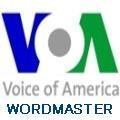AA: I'm Avi Arditti with Rosanne Skirble, and this week on WORDMASTER: We're back with Virginia Berninger, an educational psychology professor at the University of Washington in Seattle. RS: A study she and her colleagues did found that children in fourth and sixth grade wrote longer essays when they were writing by hand than when they were typing on a keyboard. The children also wrote the words faster, and they wrote more complete sentences.
AA: But while children should learn good penmanship, Berninger says teaching handwriting by itself misses the point.
VIRGINIA BERNINGER: "What our research and other people's research is showing is, starting around kindergarten, first grade, kids really do best when you integrate writing with the reading and you start with idea expression. You have them put their ideas on paper, and then you build into that some instruction in handwriting and spelling.
"But the ultimate goal is to express their ideas. And they can do it. We do not recommend drill of handwriting or spelling in isolation. It is always taught in a way for the children to transfer it, to idea expression, which is the true purpose of writing. And that cognitive writing emerges around age six." AA: "And you're saying it should be taught that way." VIRGINIA BERNINGER: "Oh, absolutely." RS: "What I hear you saying is that it should be taught in context, which is how language -- second language learners learn a language. Or any language learner learns a language best." VIRGINIA BERNINGER: "We teach a strategy -- and this was developed by Jennifer Katahira in the Seattle public schools -- 'What I think, I can say. What I say, I can write.' So the teacher models a very, very short sentence. Starting with kindergarten, it might be a sentence or two long. Then the children think out loud, and they use little cue cards that help them with forming letters and getting sounds that go with letters.
"So as they say their ideas out loud, they then think about the sounds and the letters that go with it. They write it down. At the end they always read it to their writing buddies. We have audience from the beginning. And what we found, when children do that kind of writing, they actually become very good readers, too." AA: "I'm curious, how common is it from your experience, that writing is taught in isolation? In just drill-and-kill, maybe is what you might call it." VIRGINIA BERNINGER: "Now a colleague of mine, Steve Graham, does surveys of teachers' practices, and he finds either teachers are only teaching handwriting and spelling incidentally -- you know, when they think it's appropriate, it's very casual -- or they're very into the skills, you know, just drilling the skills. "From my experience working in the schools, there are fewer people integrating the teaching of the handwriting and spelling with the idea expression. They either do writers' workshop and idea expression and social context, or they work on skills for the sake of skills -- kind of drill in isolation, the old penmanship model. That's not what our research is showing works. It's the combining of the two approaches: writing for idea expression, and then teaching the transcription skills." AA: "What do you think, based on all your experience -- I mean, what we hear now is, we see the kids texting and typing on their computers and so forth, do you have any sense ... I know your research is restricted to the younger kids, but in terms of idea expression or creativity, do you have any sort of hunches of what this is meaning? Because the trend seems to be away from handwriting, the old fashioned way, more toward computer mediated writing." VIRGINIA BERNINGER: "We haven't done the studies with adolescents. There are some people in other countries doing this research now, and I'm aware of some that are finding similar things. We do know from a lot of writing research that computers are very, very good for the revision process. It may just be that that first draft benefits by producing it by hand." RS: Virginia Berninger is a professor of educational psychology at the University of Washington in Seattle. She's put together a list of resources for teaching writing. You can find it, along with the first part of our interview, at our Web site, voanews.com/wordmaster.
AA: Where you can also send us comments and get our weekly podcast. And that's WORDMASTER for this week. With Rosanne Skirble, I'm Avi Arditti.

